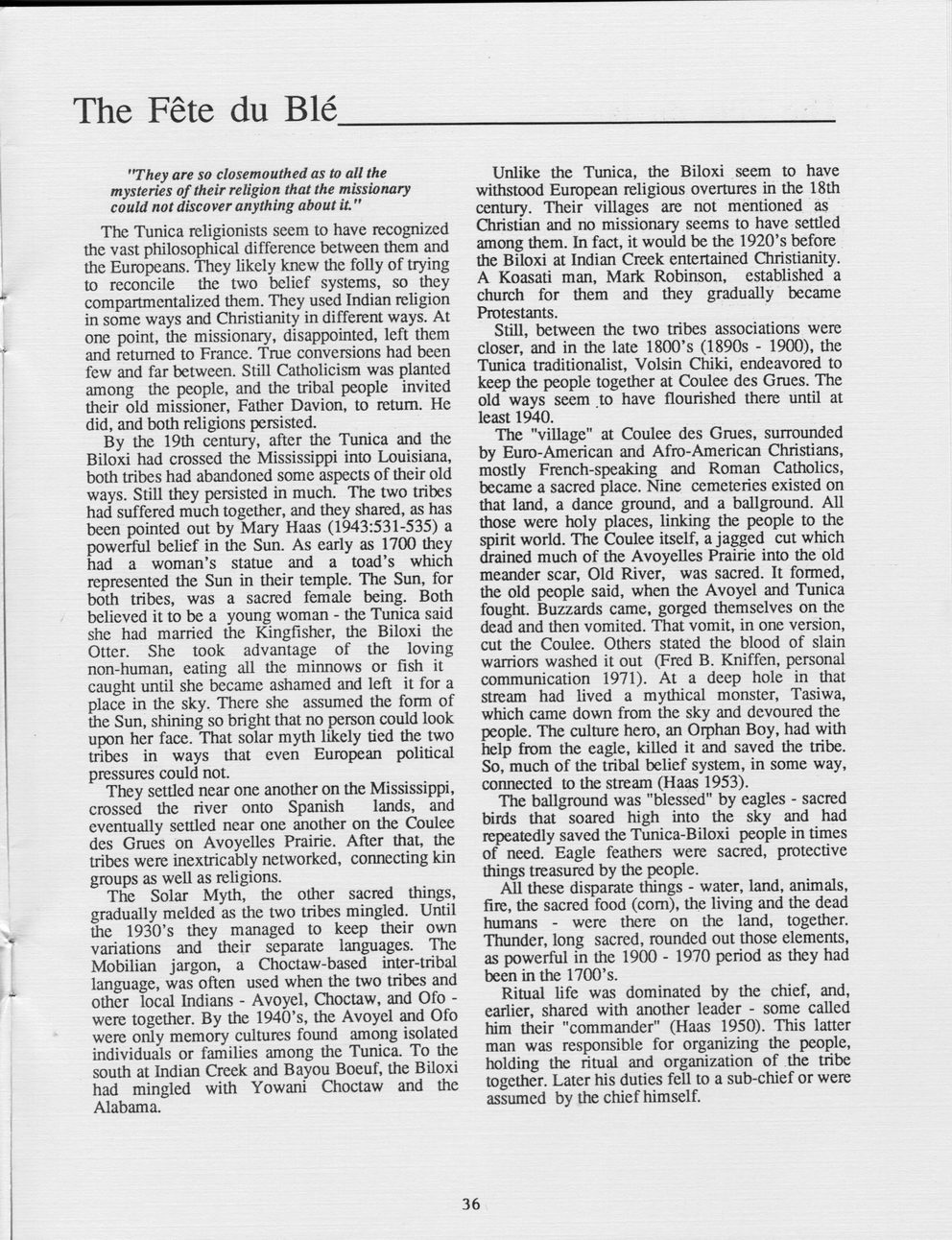This text was obtained via automated optical character recognition.
It has not been edited and may therefore contain several errors.
The Fete du Ble "They are so closemouthed as to all the mysteries of their religion that the missionary could not discover anything about it. ” The Tunica religionists seem to have recognized the vast philosophical difference between them and the Europeans. They likely knew the folly of trying to reconcile the two belief systems, so they compartmentalized them. They used Indian religion in some ways and Christianity in different ways. At one point, the missionary, disappointed, left them and returned to France. True conversions had been few and far between. Still Catholicism was planted among the people, and the tribal people invited their old missioner, Father Davion, to return. He did, and both religions persisted. By the 19th century, after the Tunica and the Biloxi had crossed the Mississippi into Louisiana, both tribes had abandoned some aspects of their old ways. Still they persisted in much. The two tribes had suffered much together, and they shared, as has been pointed out by Mary Haas (1943:531-535) a powerful belief in the Sun. As early as 1700 they had a woman’s statue and a toad’s which represented the Sun in their temple. The Sun, for both tribes, was a sacred female being. Both believed it to be a young woman - the Tunica said she had married the Kingfisher, the Biloxi the Otter. She took advantage of the loving non-human, eating all the minnows or fish it caught until she became ashamed and left it for a place in the sky. There she assumed the form of the Sun, shining so bright that no person could look upon her face. That solar myth likely tied the two tribes in ways that even European political pressures could not. They settled near one another on the Mississippi, crossed the river onto Spanish lands, and eventually settled near one another on the Coulee des Grues on Avoyelles Prairie. After that, the tribes were inextricably networked, connecting kin groups as well as religions. The Solar Myth, the other sacred things, gradually melded as the two tribes mingled. Until tJie 1930’s they managed to keep their own variations and their separate languages. The Mobilian jargon, a Choctaw-based inter-tribal language, was often used when the two tribes and other local Indians - Avoyel, Choctaw, and Ofo -were together. By the 1940’s, the Avoyel and Ofo were only memory cultures found among isolated individuals or families among the Tunica. To the south at Indian Creek and Bayou Boeuf, the Biloxi had mingled with Yowani Choctaw and the Alabama. Unlike the Tunica, the Biloxi seem to have withstood European religious overtures in the 18th century. Their villages are not mentioned as Christian and no missionary seems to have settled among them. In fact, it would be the 1920’s before the Biloxi at Indian Creek entertained Christianity. A Koasati man, Marie Robinson, established a church for them and they gradually became Protestants. Still, between the two tribes associations were closer, and in the late 1800’s (1890s - 1900), the Tunica traditionalist, Volsin Chiki, endeavored to keep the people together at Coulee des Grues. The old ways seem to have flourished there until at least 1940. The "village" at Coulee des Grues, surrounded by Euro-American and Afro-American Christians, mostly French-speaking and Roman Catholics, became a sacred place. Nine cemeteries existed on that land, a dance ground, and a ballground. All those were holy places, linking the people to the spirit world. The Coulee itself, a jagged cut which drained much of the Avoyelles Prairie into the old meander scar, Old River, was sacred. It formed, the old people said, when the Avoyel and Tunica fought. Buzzards came, gorged themselves on the dead and then vomited. That vomit, in one version, cut the Coulee. Others stated the blood of slain warriors washed it out (Fred B. Kniffen, personal communication 1971). At a deep hole in that stream had lived a mythical monster, Tasiwa, which came down from the sky and devoured the people. The culture hero, an Orphan Boy, had with help from the eagle, killed it and saved the tribe. So, much of the tribal belief system, in some way, connected to the stream (Haas 1953). The ballground was "blessed" by eagles - sacred birds that soared high into the sky and had repeatedly saved the Tunica-Biloxi people in times of need. Eagle feathers were sacred, protective things treasured by the people. All these disparate things - water, land, animals, fire, the sacred food (com), the living and the dead humans - were there on the land, together. Thunder, long sacred, rounded out those elements, as powerful in the 1900 - 1970 period as they had been in the 1700’s. Ritual life was dominated by the chief, and, earlier, shared with another leader - some called him their "commander" (Haas 1950). This latter man was responsible for organizing the people, holding the ritual and organization of the tribe together. Later his duties fell to a sub-chief or were assumed by the chief himself. 36

Native Americans The-Tunica-Biloxi-Tribe-its-Culture-and-People-(45)